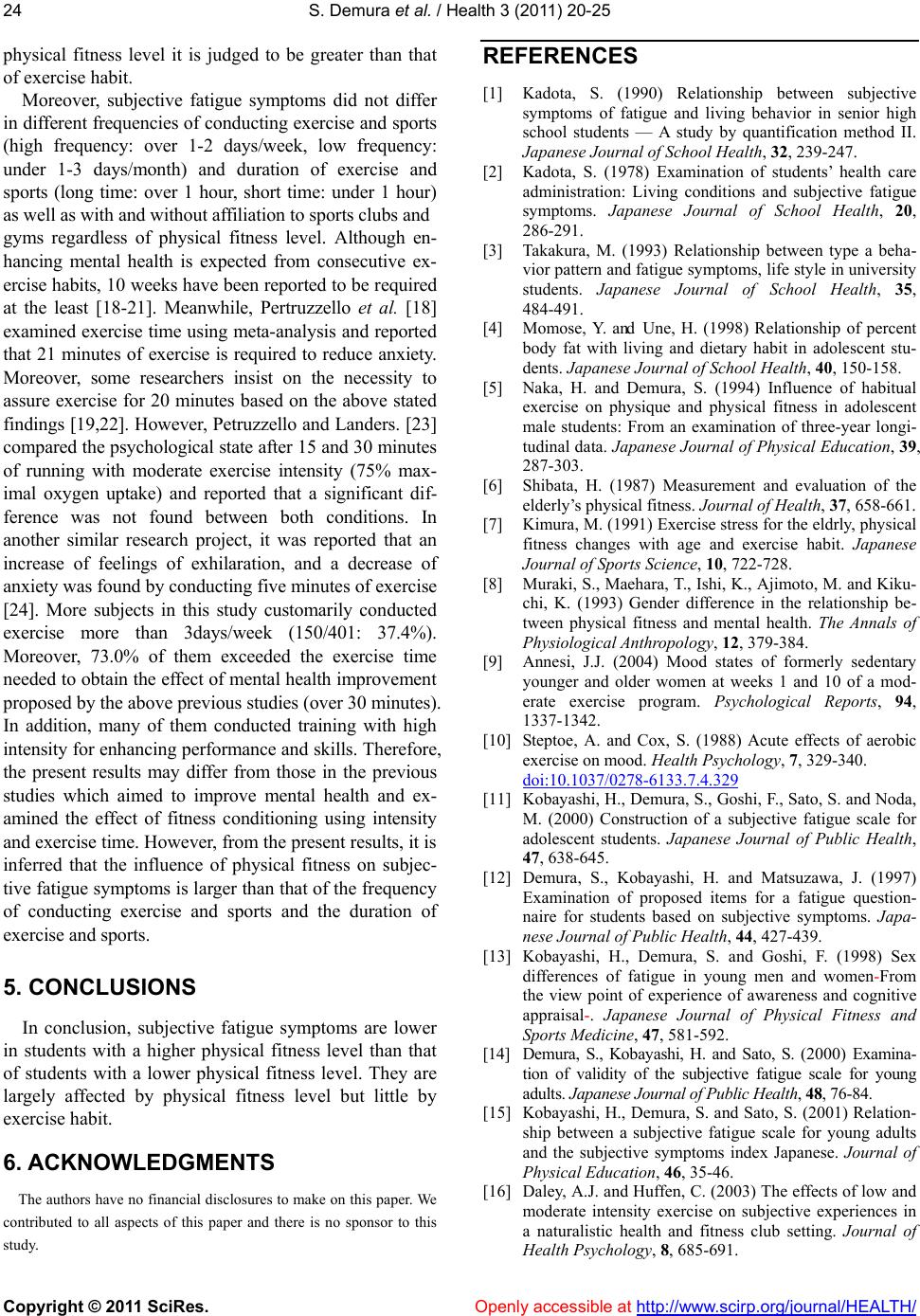
S. Demura et al. / Health 3 (2011) 20-25
Copyright © 2011 SciRes. Openly accessible at http://www.scirp.org/journal/HEALTH/
physical fitness level it is judged to be greater than that
of exercise habit.
Moreover, subjective fatigue symptoms did not differ
in different frequencies of conducting exercise and sports
(high frequency: over 1-2 days/week, low frequency:
under 1-3 days/month) and duration of exercise and
sports (long time: over 1 hour, short time: under 1 hour)
as well as with and without aff iliation to sport s c lubs and
gyms regardless of physical fitness level. Although en-
hancing mental health is expected from consecutive ex-
ercise habits, 10 w eeks have been repor ted to be required
at the least [18-21]. Meanwhile, Pertruzzello et al. [18]
examined exercise time using meta-analysis and reported
that 21 minutes of exercise is required to reduce anxiety.
Moreover, some researchers insist on the necessity to
assure exercise for 20 minutes based on the above stated
findings [19,22]. However, Petruzzello and Landers. [23]
compared the psychological state after 15 and 30 minutes
of running with moderate exercise intensity (75% max-
imal oxygen uptake) and reported that a significant dif-
ference was not found between both conditions. In
another similar research project, it was reported that an
increase of feelings of exhilaration, and a decrease of
anxiety was found by conducting five minutes of exercise
[24]. More subjects in this study customarily conducted
exercise more than 3days/week (150/401: 37.4%).
Moreover, 73.0% of them exceeded the exercise time
needed to obtain the effect of mental health improvement
proposed by the above previous studies (over 30 minutes).
In addition, many of them conducted training with high
intensity for enhancing performance and skills. Therefore,
the present results may differ from those in the previous
studies which aimed to improve mental health and ex-
amined the effect of fitness conditioning using intensity
and exercise time. However, from the present results, it is
inferred that the influence of physical fitness on subjec-
tive fatigue sy mptoms is larger than that of the frequency
of conducting exercise and sports and the duration of
exercise and sports.
5. CONCLUSIONS
In conclusion, subjective fatigue symptoms are lower
in students with a higher physical fitness level than that
of students with a lower physical fitness level. They are
largely affected by physical fitness level but little by
exercise habit.
6. ACKNOWLEDGMENT S
The authors have n o financial disclosures to make on this paper. We
contributed to all aspects of this paper and there is no sponsor to this
study.
REFERENCES
[1] Kadota, S. (1990) Relationship between subjective
symptoms of fatigue and living behavior in senior high
school students — A study by quantification method II.
Japanese Journal of School Health, 32, 239-247.
[2] Kadota, S. (1978) Examination of students’ health care
administration: Living conditions and subjective fatigue
symptoms. Japanese Journal of School Health, 20,
286-291.
[3] Takakura, M. (1993) Relationship between type a beha-
vior pattern and fatigue symptoms, life style in university
students. Japanese Journal of School Health, 35,
484-491.
[4] Momose, Y. a nd Une, H. (1998) Relationship of percent
body fat with living and dietary habit in adolescent stu-
dents. Japanese Journal of School Health, 40, 15 0-158.
[5] Naka, H. and Demura, S. (1994) Influence of habitual
exercise on physique and physical fitness in adolescent
male students: From an examination of three-year longi-
tudinal data. Japanese Journal of Physical Education, 39,
287-303.
[6] Shibata, H. (1987) Measurement and evaluation of the
elderly’s physical fitness. Journal of Health, 37, 658-661.
[7] Kimura, M. (1991) Exercise stress for the eldrly, physical
fitness changes with age and exercise habit. Japanese
Journal of Sports Science, 10, 722-728.
[8] Muraki, S., Maehara, T., Ishi, K., Ajimoto, M. and Kiku-
chi, K. (1993) Gender difference in the relationship be-
tween physical fitness and mental health. The Annals of
Physiological Anthropology, 12, 379-384.
[9] Annesi, J.J. (2004) Mood states of formerly sedentary
younger and older women at weeks 1 and 10 of a mod-
erate exercise program. Psychological Reports, 94,
1337-1342.
[10] Steptoe, A. and Cox, S. (1988) Acute effects of aerobic
exercise on mood. Health Psychology, 7, 329-340.
doi:10.1037/0278-6133.7.4.329
[11] Kobayashi, H., Demura, S., Goshi, F., Sato, S. and Noda,
M. (2000) Construction of a subjective fatigue scale for
adolescent students. Japanese Journal of Public Health,
47, 638-645.
[12] Demura, S., Kobayashi, H. and Matsuzawa, J. (1997)
Examination of proposed items for a fatigue question-
naire for students based on subjective symptoms. Japa-
nese Journal of Public Health, 44, 427-439.
[13] Kobayashi, H., Demura, S. and Goshi, F. (1998) Sex
differences of fatigue in young men and women-From
the view point of experience of awareness and cognitive
appraisal-. Japanese Journal of Physical Fitness and
Sports Medicine, 47, 581-592.
[14] Demura, S., Kobayashi, H. and Sato, S. (2000) Examina-
tion of validity of the subjective fatigue scale for young
adults. Japanese Journal of Public Health, 48, 76-84.
[15] Kobayashi, H., Demura, S. and Sato , S. (2001) Relation-
ship between a subjective fatigue scale for young adults
and the subjective symptoms index Japanese. Journal of
Physical Education, 46, 35-46.
[16] Daley, A.J. and Huffen, C. (2003) The effects of low and
moderate intensity exercise on subjective experiences in
a naturalistic health and fitness club setting. Journal of
Health Psychology, 8, 685-691.